
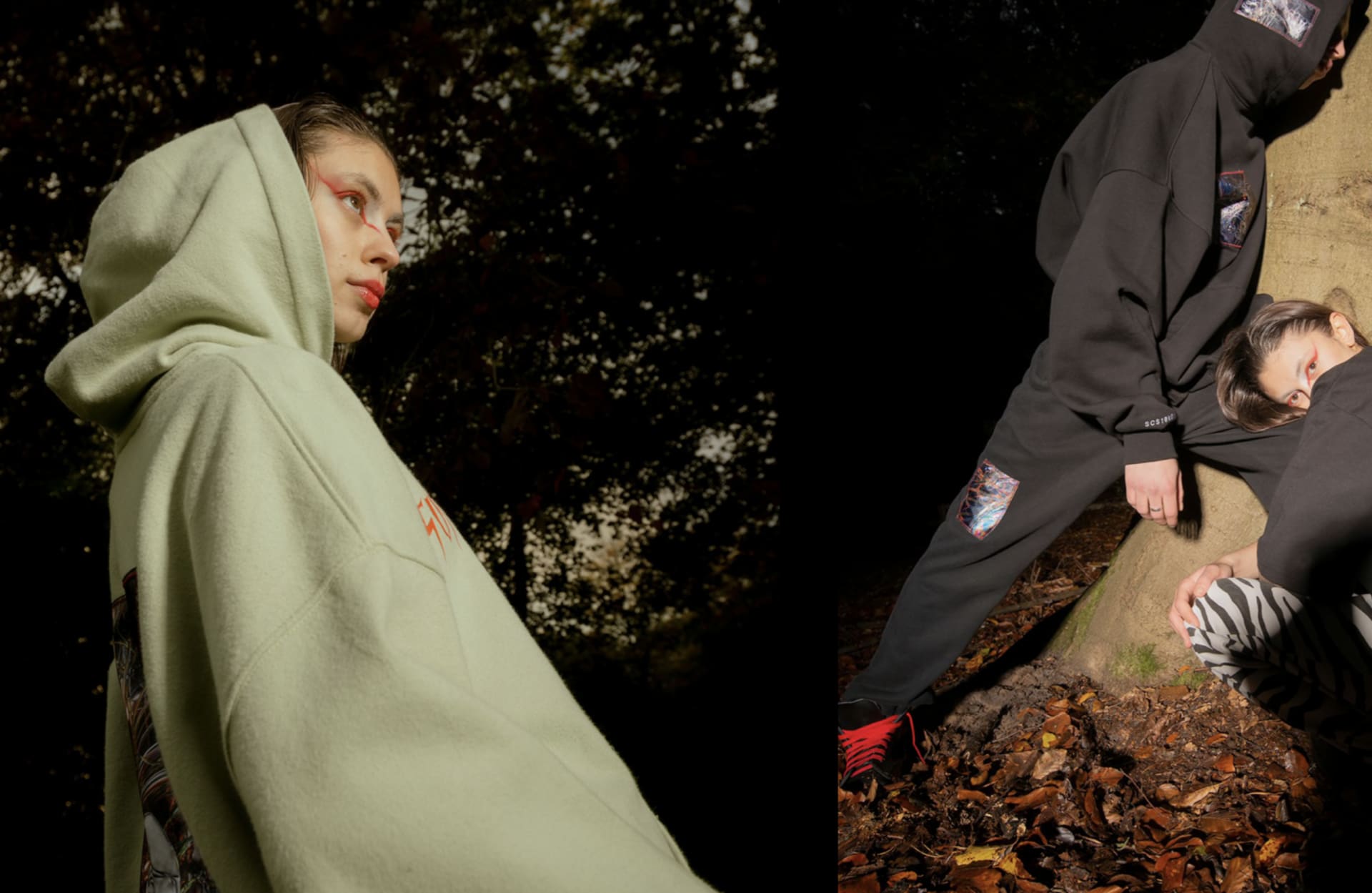
Human Evolution with Superconscious and Giusy Amoroso
We talked to digital artist Giusy Amoroso about superhuman exoskeletons, recreating nature in the digital sphere, and designing IOR50's capsule with German brand Superconscious.
For their latest high-concept, one-off capsule collection, German fashion brand and store Superconscious (which also happens to be an Electronic Beats book stockist) dug into its own DNA, collaborating with digital artist Giusy Amoroso of IOR50 Studio, whose futuristic skeletal artworks, they feel, reflect the concept of “Superconscious.”
In digitally sculpting the artworks for the collection, Amoroso investigated intricacies of human anatomy and nature and questioned how they could be improved—culminating in a series of digitally-rendered, metallic exoskeletons, printed on the garments in a fashion that makes them appear fluid and nearly transparent. In the lead up to the capsule collection’s release on April 15th, we spoke with Giusy Amoroso about her ever-evolving process, the link between the natural and technological worlds, and what it means to be Superconscious.
How did you start to experiment with CGI and VR?
My educational background has formed the base of certain aspects of my artistry. I studied product design in Rome. Back then, we would design industrial objects or furniture to then implement into CGI software. I have always been fascinated by the possibility to transform a sketch into a 360-degree digital sculpture—something that one can interact with, something to visualize movement and momentum.
The possibility to create characters, universes, or even multiverses with CGI and VR has pushed my perception of creation. I can translate philosophical themes, self-reflection, or any type of inspiration to form entities, textures, and simulations and create worlds of their own. One can say that I applied my educational skills to the intellectual content of my art.
Tell us a bit about your creative process. How do you approach new projects?
There is no standard approach to my creative process. Every project I get involved with is different. I draw inspiration from all kinds of sources and always set the goal to develop an organic workflow. I don’t like to restrain myself too much in how I approach things.
Sometimes I try to visualize feelings, a mindset, or an energy by using a sketch or even verbalizing it through words. I draw or write things down before I use any tool to digitize things. First, I narrow down a clear idea. Only then I turn to different formats of media, such as CGI, Extended Reality, immersive real-time environments, animation, and character design to articulate that idea.
If a new project is commissioned by a client, the starting point will always be the interest of the client. From that interaction and his or her expectations, I can organically develop a customized way to fulfill their needs. If the project is of personal matter, I try to elaborate on my own thoughts by blurring different ways of brainstorming.
What philosophical themes or personal inspiration have you channeled in past digital sculptures?
My past works fundamentally take nature as their core inspiration. If you interpret nature as technology or as “biotechnological design,” the philosophical theme consequently becomes, Is there a God? Who has created all this? Or are there strange entities that control us in a simulation? These lead to another question: Are we able to achieve the same through our own creations?
These thoughts are the foundation for the look of a digital sculpture, as they could potentially be part of a broader conversation. But I prefer not to be restricted by them. I would say that the variety of fractals within nature is the main inspiration behind my digital sculpting—textures, surfaces, elements of mobility, creatures, the woods, the ocean, or the skies.
Quantum science and nature reprogramming itself also fascinate me. Evolution is a process of reprogramming. One could say that a lot of my digital art visually reinterprets a possibility of our own evolution. Who knows if we have a creator? Who can possibly say if we might already be Gods?
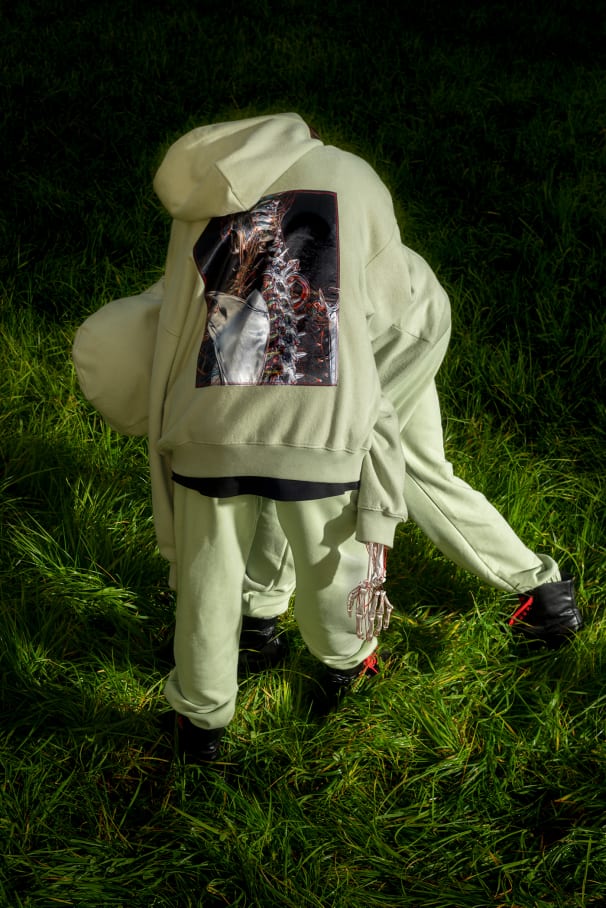
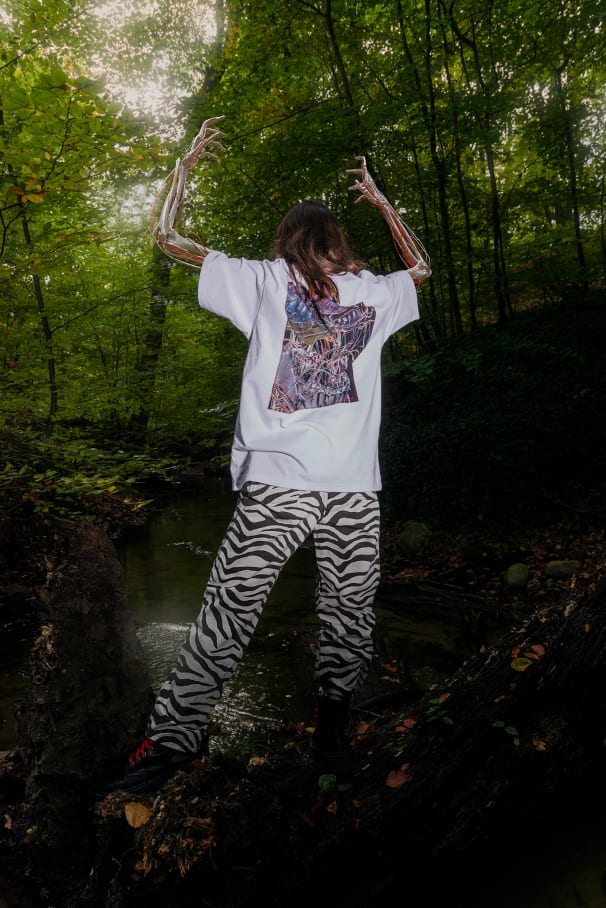
What aspects of nature, outside of those above, have you drawn from in your work?
For past and present works I have also looked into aquamarine ecosystems. For example, when working on Dixon´s set for Boiler Room’s “From Isolation” and his platform Transmoderna, I was highly inspired by the ocean. I was responsible for the CG Art co-direction of the digital environment and its animated creatures. For me, it is very important to learn from nature but to abstract parts of it, to fracturally mimic it, and to finally create something completely new.
Natural environments such as the forest or ocean can build an inspirational frame for designing complex CG environments, and they can also draw the contrast between two themes. For the lookbook of the capsule collection with Superconscious, for example, I created a humanoid evolution in the form of an exoskeleton contrasted by actual biotechnological design of flora and fauna of the forest.
Can you tell us more about the inspiration behind your collection with Superconscious?
For the collaborative capsule collection, we wanted to express the symbiotic connection between digital art and fashion, bridging between the digital multiverse of limitless creation and the physical world of garments that cover our bodies in the simulation that we all refer to as reality. The collection is based around the concept of a transcendental experience, the transformation into a higher self.
The founders of Superconscious, Nikolai Goutzov and Simeon Dimitrov, approached me personally because this specific exoskeleton artwork contextually represents the brand’s DNA to its full extent. To them, it translates a feeling of “Superconsciousness”.
Through my artwork pieces featuring metal and chrome skeletons, my goal is to reinterpret the structure of human nature and the anatomy of flesh, bones, and nerves by digitizing and creating a nature of its own—in the final, superior appearance of an exoskeleton. Nature itself is nothing more than a technology that may have been created for us, to mold us into the form and the physical shape that we are in.
The artwork is fueled by the philosophical and enlightening idea that one can reach a higher form and free mind and body by creating something detached from the known. The possibility of reprogramming ourselves on a quantum level additionally fuels the idea that our creator or creators have constructed this world for us. Equally, we have the power to create worlds, creatures, and entities, even identities and selves in the digital multiverse. For that, the exoskeleton as a digital art piece is simply a reinterpretation of nature itself.
The art direction of this collaboration seen in the lookbook mimics the dualistic idea of nature as a technology by our creators, which stands in contrast to the digital technology and the look created by digital artists as myself. The goal is to establish and define a new zeitgeist of style: a transcendental and hypnotizing bridge between the digital multiverse and sports/streetwear.






How do you feel about housing your designs on physical garments? How do you feel the shape and design of the collaborative garments compliment or contrast with the artwork and its underlying philosophy?
This [the Superconscious capsule collection] is the first time that my artwork has been fused with physical garments. I have always been very exclusive with the idea of putting my art on clothing. It was important to me that quality, sustainability, and concept were equally important, and that all of those factors were met to the highest standard.
I also contributed the artwork because the founders of Superconscious agreed to let me participate in the full creative process. They entrusted me with new logotype designs, the CGI art direction, and the creative direction for the lookbook. Together, we went through several trials of prototypes to find the right print technique for the artwork. The goal was to never compromise on the quality nor the look of the print. In the end, we agreed on a one-of-a-kind print technique on a poly fabric that best translates the digital artwork into a physical shape. The details of the exoskeleton’s metal and chrome plates and multi-colored wire-nerves are emphasized by the shining and reflecting prints, giving the images an almost x-ray feel.
This attention to detail enabled us to create a six-piece capsule collection that is thought through in every single way. All pieces differ from each other, as the different artworks are placed to perfectly fit with the color and cuts of each piece. I am very proud of the result and, of course, hope that digital art and the community are pushed and empowered by the fact that we have placed digital art on another canvas. I also hope to raise more awareness for the endless possibilities of the digital multiverse by contributing my work to this project.
What was the process like working with 10K (the manufacturer)? How did they add physical detail that ground your vision in the physical?
We planned all the designs with red zig-zag stitching and black line stitching on 400g organic cotton jersey as well as on 230g heavyweight organic cotton T-shirts. They feel heavy and dense, the quality is amazing, and we are all excited to see it on people that value the design and its process.
All the specifications and requirements were met by 10K, and the manufacturer really helped to realize our vision. They only use 100% certified organic cotton, and they produce their clothes according to the principles of Standard 100 by Oekotex. They are also GOTS and BSCI certified.
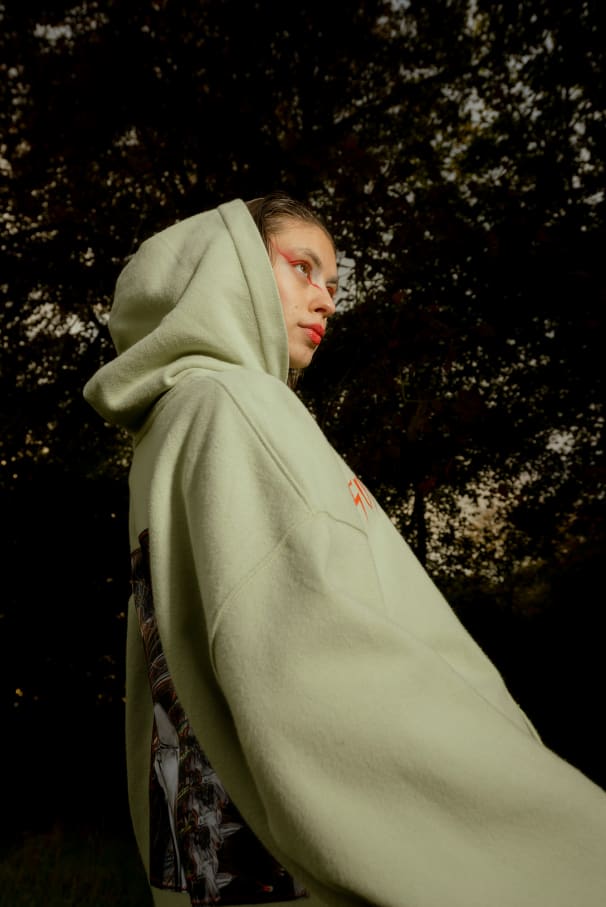
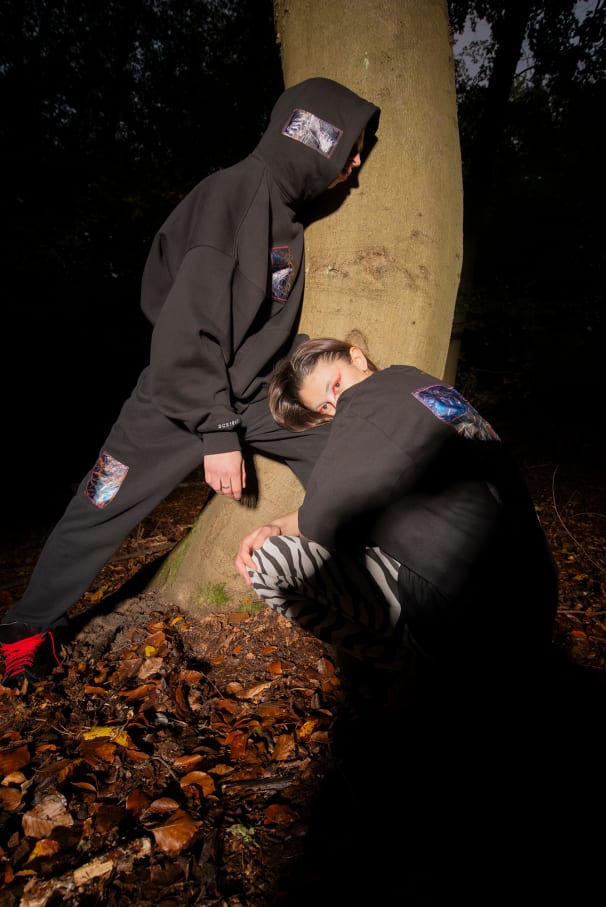
You mention that Superconscious can mean, to you, “transcendence and transformation into a higher self.” What characteristics, to you, would make an ideal higher self? Is it the ability to create entire worlds in the digital sphere, or is it something more?
The search to become a “higher self” begins from the inside. Reflection and acceptance of oneself leads to a higher consciousness. This is what makes you truly Superconscious, to be thankful and humble about life itself. I am very thankful for every opportunity and every project that I get involved with. They all give me the possibility to look at nature or life from different perspectives, and to draw conclusions about my inner feelings.
The ability to build these worlds isn’t really a characteristic of becoming a higher self, though. It is important to get rid of your ego. To see your own creation as such an outlet would be too egotistic. (Also because the best art is always at least partially autobiographical.)
The digital sphere is for new creations, which hopefully remind us of something deeper—to look into our own programming. The reprogramming of oneself starts from the inside, and it is our own responsibility. Creation is an external form of expression, there to communicate our deepest thoughts. If done right, art in the digital sphere may inspirationally guide us back to where we can truly become higher: Back into our own code.
Do you have any other projects coming up? What do you hope to express in future works?
I am currently working with an artist that will build a real-life sculpture from one of my digital ones, which will be exhibited in London. This project shows how digital work circulates and reconnects to the physical world, just like the Superconscious collaboration. We take things that were meant for the digital multiverse and place them into our reality. Beyond that, I have commissioned work for a new music video, which I’m afraid I can’t give too much detail about. Let’s just say it will be electronic music-relevant.
For my future works, I hope to contextually continue with references to nature, and to focus more on my own digital art. I really hope that my work will continue to evolve just like nature, into more complex and miraculous ecosystems of storytelling.
The Superconscious X Giusy Amoroso capsule collection will be available via the Superconscious website on April 15th.
CAPSULE COLLECTION FULL CREDITS:
Art direction and design: Giusy Amoroso @marigoldff / IOR50 Studio @ior50.studio
Brand: Superconscious Berlin @superconsciousberlin
Photography: Jaewon Chung @jaewonchung
Backstage ph: Hyesoo Chung @hyesoo.chung
MUA: Leana Ardeleanu @leana.ardeleanu
Models: Lupo @lupodanslamatrix, Petra Popangelova @pe.trapp
Hang tag design: Luca Devinu@blssnd
Writer / Producer: Manfred Enrique Blitz
Published April 07, 2021.









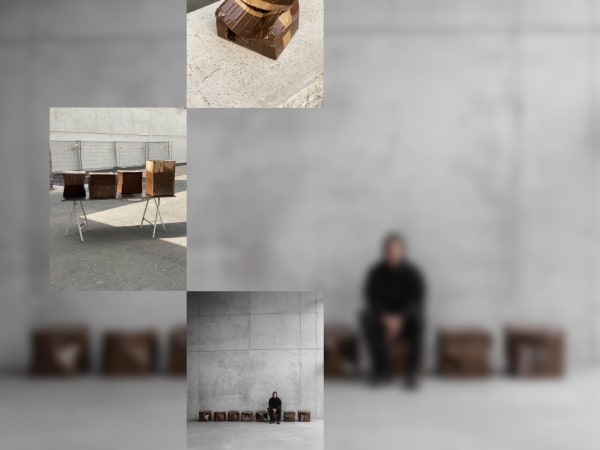


Follow @electronicbeats